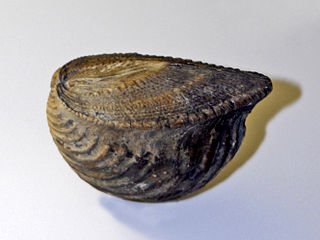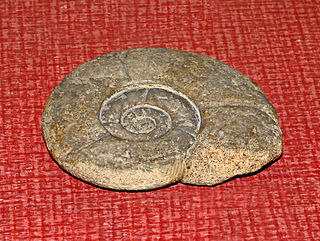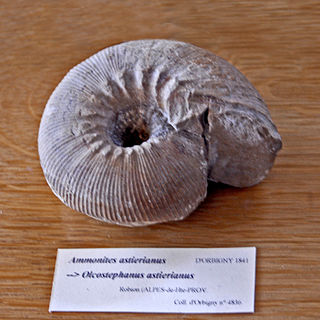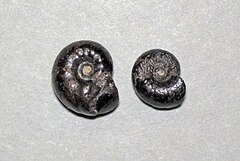
Eubostrychoceras is a genus of helically wound, corkscrew form, heteromorph ammonite which lived during the Upper Cretaceous. The genus is included in the ancycleratid family Nostoceratidae.

Cymatoceras is a wide-ranging extinct genus from the nautilitacean cephalopod family, Cymatoceratidae. They lived from the Late Jurassic to Late Oligocene, roughly from 155 to 23 Ma.

Calliphylloceras is an ammonite belonging to the Phylloceratidae.

Pachydesmoceras is a genus of ammonites belonging to the family Desmoceratidae.

Calycoceras is an extinct genus of cephalopods belonging to the subclass Ammonoidea and family Acanthoceratidae that lived during the Cenomanian stage of the Late Cretaceous, 100-94 Mya. Their shells had ornate ribs.

Strophomena is a genus of brachiopods belonging to the order Strophomenida family Strophomenidae, named by Rafinesque in 1824. They were stationary epifaunal suspension feeders.

Hauericeras is an ammonite genus from the Late Cretaceous that lived from the Coniacian to the late Maastrichtian, from about 90 to 66 mya. Fossils have been found in Europe, Russia, South Africa, Australia, India, Iraq, and in the United States.

Trigonia is an extinct genus of saltwater clams, fossil marine bivalve mollusk in the family Trigoniidae. The fossil range of the genus spans the Paleozoic, Mesozoic and Paleocene of the Cenozoic, from 298 to 56 Ma.

Puzosia is a genus of desmoceratid ammonites, and the type genus for the Puzosiinae, which lived during the middle part of the Cretaceous, from early Aptian to Maastrichtian. Sepkoski defines the range from Albian to Santonian. The generic name comes from the Serbian words "Puž" (snail) and "oce/ose" (axis), gaining its name from the shell's snail-like appearance.

Pterotrigonia is an extinct genus of saltwater clams, marine bivalve molluscs in the family Megatrigoniidae. This genus is known in the fossil record from the Jurassic period Tithonian age to the Cretaceous period Maastrichtian age. Species in this genus were facultatively mobile infaunal suspension feeders. The type species of the genus is Pterotrigonia cristata.

Phyllopachyceras is an extinct genus of ammonoid cephalopods belonging to the family Phylloceratidae. These nektonic carnivores lived in the Cretaceous, from Hauterivian to Maastrichtian to age.

Protetragonites is an extinct genus of ammonoid cephalopods belonging to the family Lytoceratidae. These fast-moving nektonic carnivores lived from the Jurassic period Tithonian age to the Cretaceous period Aptian age.

Pseudothurmannia is a genus of extinct cephalopods belonging to the subclass Ammonoidea and included in the family Crioceratitidae of the ammonitid superfamily Ancylocerataceae. These fast-moving nektonic carnivores lived in the Cretaceous period, from Hauterivian age to Barremian age.

Kossmaticeras is an extinct ammonoid genus belonging to the desmoceratacean family Kossmaticeratidae. Species in this genus were fast-moving nektonic carnivores. They lived during the Late Cretaceous, from upper Turonian to upper Maastrichtian age. The type species of the genus is Ammonites theobaldianus.

Dufrenoyia is an extinct genus of Cretaceous ammonites included in the family Parahoplitidae. These fast-moving nektonic carnivores lived in the Cretaceous period. The type species of the genus is Ammonites dufrenoyi.

Vascoceras is an extinct genus of Cretaceous ammonites included in the family Vascoceratidae. These fast-moving nektonic carnivores lived in the Cretaceous period from the late Cenomanian to the early Turonian. The type species of the genus is Vascoceras gamai from Portugal.

Sonneratia is an extinct genus of Cretaceous ammonites included in the family Hoplitidae. These fast-moving nektonic carnivores lived in the Cretaceous period, Aptian - Albian age.

Olcostephanus is an extinct ammonoid cephalopod genus belonging to the family Olcostephanidae. These fast-moving nektonic carnivores lived during the Cretaceous, from the upper Valanginian to the lower Hauterivian age.

Gaudryceras is an ammonite genus belonging to the family Gaudryceratidae.

Rastellum is an genus of extinct molluscs, which lived from the Middle Jurassic to the Late Cretaceous.























